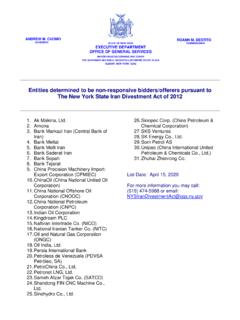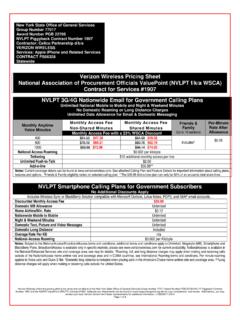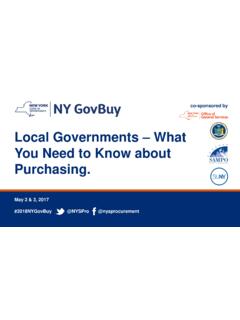Transcription of NYS Procurement Guidelines - Office of General Services
1 NEW YORK STATE Procurement Guidelines MAY 2014 TABLE OF CONTENTS I. OVERVIEW .. 1 A. Introduction and Purpose .. 1 B. Terminology .. 1 C. Application and Scope of Guidelines .. 2 D. Competition and Maintaining a Fair and Open Process .. 2 II. Procurement BASICS .. 4 A. Overview of Procurement Tools .. 4 B. Choosing a Procurement Vehicle and the Order of Purchasing Priority .. 4 C. Preferred Source Offerings .. 6 D. 6 OGS Centralized Contracts .. 7 OGS or 7 Backdrop Contracts .. 8 Agency or Multi-Agency Established Contracts .. 8 E. Discretionary Purchases .. 9 F. Procurement Card Program .. 10 G. Purchase Orders .. 11 H. Purchase Authorizations .. 11 I. Interagency Memorandum of Understanding .. 12 III. General GUIDANCE FOR SOLICITATIONS .. 13 A. Introduction .. 13 B. Procurement Ethics .. 13 C. Mandatory Requirements .. 13 D. State Reserved Rights .. 14 E. Gathering and Exchanging Information Prior to Solicitation.
2 15 Request for Information .. 16 Request for Comment .. 16 Draft Request for Proposals .. 16 Roundtable Session .. 16 F. Procurement Lobbying Law .. 17 G. Advertising Procurement Opportunities .. 17 H. Determination of Vendor Responsibility .. 18 I. Workers Compensation Insurance and Disability Benefits Requirements .. 18 J. Bidder Debriefings .. 19 K. Contract Administration and Monitoring .. 19 New York State Procurement Guidelines IV. SPECIFIC GUIDANCE: INVITATIONS FOR BIDS .. 21 A. Introduction .. 21 B. Steps for Conducting an 21 Step 1: Develop Specifications .. 22 Step 2: Prepare the Solicitation Document .. 23 Step 3: Advertise the Procurement Opportunity .. 23 Step 4: Distribute the IFB .. 23 Step 5: Conduct Site Visits and Pre-Bid Conferences .. 24 Step 6: Answer Questions .. 24 Step 7: Receive Bids .. 24 Step 8: Conduct Bid 24 Step 9: Conduct Administrative Review of Bid Submission.
3 24 Step 10: Verify Responsiveness and Responsibility of Apparent Low Bid .. 24 Step 11: Make Award .. 25 Step 12: Obtain Approvals .. 25 Step 13: Issue Purchase Order or Contract .. 26 V. SPECIFIC GUIDANCE: REQUESTS FOR PROPOSALS .. 27 A. Introduction .. 27 B. Essential RFP Contents .. 27 Table of Contents .. 27 Description of Program Objectives and Background .. 27 Scope of Services .. 27 Detailed Requirements/Specifications .. 28 Performance Standards .. 28 Green Performance Standards .. 28 Mandatory Versus Optional Elements in the Response .. 28 Overview of the Solicitation Process .. 28 Timeline and Calendar of Events .. 29 Anticipated Start Date and Term of Contract .. 30 Method of Award .. 30 Evaluation Criteria .. 30 Offerer s Minimum Qualifications .. 30 Mandatory Requirements .. 30 Reserved Rights .. 31 Method for Issuing Clarifications or Modifications to the RFP .. 31 C. Additional Content Considerations.
4 31 Prequalification Criteria .. 31 Risk Management / Required Assurances .. 31 Cost Adjustments .. 31 References .. 31 31 New York State Procurement Guidelines D. RFP Distribution and Receipt of Proposals .. 32 Advertisement of the Solicitation .. 32 Distribution of the RFP .. 32 Receipt of Proposals .. 32 E. Evaluation of Proposals Overview .. 32 F. Evaluation Team .. 33 Separate Team Approach .. 33 Single Team/Evaluator Approach .. 34 G. Conducting the Administrative Review .. 34 H. Conducting the Technical Evaluation .. 34 Development of the Technical Evaluation Criteria .. 34 Assignment of Values to Technical Evaluation Criteria .. 35 The Technical Evaluation Instrument .. 36 Evaluating Technical Proposals .. 36 I. Conducting the Cost Evaluation .. 37 Conversion of Price to a Weighted Point Score .. 38 Comparison of Life Cycle Costs .. 38 J. Determining the Final Score .. 38 K. Agency-Recommended Award and Notification.
5 38 Agency-Recommended Award .. 38 Notification of Award .. 39 L. Contract Negotiation .. 39 M. Documentation Requirements for Control Agency Review and Approval .. 39 VI. BEST 41 A. Knowing the Business Needs .. 41 B. Proper Planning .. 41 C. Thorough Information Gathering ..41 D. Green Purchasing ..41 E. Conducting Pre-Bid Conferences .. 42 F. Providing for Site Visits .. 42 G. Discussion with the Office of the State Comptroller .. 43 H. Use of Destination .. 43 I. Review of Terms and Conditions Proposed by Vendors .. 43 J. Negotiating Effectively .. 43 K. Involving Upper Management .. 44 L. Documenting .. 44 M. Adapting Standard Formats to the Specific Procurement .. 44 N. Insurance Requirements .. 45 New York State Procurement Guidelines VII. 46 VIII. EXHIBITS .. 53 A. SAMPLE OUTLINE FOR AN INVITATION FOR BIDS .. 53 B. SAMPLE OUTLINE FOR A REQUEST FOR PROPOSALS .. 54 C. GREEN PURCHASING .. 56 New York State Procurement Guidelines I.
6 OVERVIEW A. Introduction and Purpose New York State ( State ) agencies must procure commodities, Services , and technology in accordance with Article 11 of the New York State Finance Law. The Procurement Guidelines ( Guidelines ) presented in this document are established by the State Procurement council pursuant to State Finance Law 161(2)(d). The Guidelines are designed to assist State agencies in making procurements efficiently and effectively by providing agency program and fiscal staff with a source of basic, systematic guidance about State Procurement policies and practices. State Procurement must facilitate each agency's mission while protecting the interests of the State and its taxpayers, on the one hand, and promoting fairness in contracting with the business community, on the other. The Guidelines are intended to advance these goals by encouraging agencies to adopt and implement appropriate Procurement practices consistent with State policies.
7 The State s Procurement policies form a framework for conducting procurements and establishing contracts. Policies address such issues as ensuring sufficient competition, preserving fair and open competition, establishing vendor responsibility, providing for participation of State certified minority- and women- owned business enterprises as well as service disabled veteran owned small businesses, promoting local food growers, and protecting human health and the environment. When conducting procurements, each agency may have supplemental policies and requirements that should also be reviewed and followed. B. Terminology Becoming familiar with the vocabulary is fundamental to understanding and properly performing procurements. In these Guidelines , important terms will appear in blue italicized bold face upon first use (as demonstrated in this paragraph) and are defined in Chapter VII: Glossary. Some terms are used interchangeably.
8 For example, an entity that provides commodities, Services , or technology may be variously, and often interchangeably, referred to as a vendor, offerer, bidder, proposer, or contractor. Similarly, the words service or Services , when used in these Guidelines , are meant to include both Services and technology (as each term is separately defined in the Glossary), unless the context indicates that the meaning is expressly directed at one or the other term. Additionally, the words products and goods are used to mean commodities. 1 New York State Procurement Guidelines C. Application and Scope of Guidelines The Guidelines are designed to apply to a wide range of procurements, from the very routine to the very complex. The applicability of specific chapters, sections, and provisions will vary depending on the nature, objectives, and particular circumstances of each Procurement . The Guidelines presented in this document do not govern the following types of contracts, for which different, distinct Procurement laws, rules and processes are in place: Revenue contracts; construction contracts covered by 8 of the New York State Public Buildings Law, 38 of the New York State Highway Law, and 376 of the New York State Education Law; Contracts with not-for-profit organizations covered by Article 11-B of the New York State Finance Law; Contracts for architectural, surveying or engineering Services covered under 136-a of the New York State Finance Law; Transactions that are covered under the New York State Real Property Law; and Monetary thresholds and approval processes for purchases made under the SUNY Flex legislation (Education Law and ) and CUNY Flex legislation (Education Law 6218).
9 D. Competition and Maintaining a Fair and Open Process As mentioned above, the State's Procurement process is designed to: Ensure fair and open competition; Guard against favoritism, improvidence, extravagance, fraud and corruption; Ensure that the results meet agency needs; Provide for checks and balances to regulate and oversee agency Procurement activities; and Protect the interests of the State and its taxpayers. Competition in the Procurement process serves both State agencies and potential offerers by ensuring that the Procurement process produces an optimal solution at a reasonable price; and allowing qualified vendors an opportunity to obtain State business. The primary responsibility for Procurement rests with State agencies. In addition to complying with existing statutory and regulatory requirements, State agencies must conduct procurements in accordance with the following General principles: Make reasonable efforts to ensure that vendors are aware of opportunities to compete for State business; 2 New York State Procurement Guidelines Define the process by which the Procurement is being conducted; Disclose the General process to potential offerers; Adhere to the process while conducting the Procurement ; and Document the process, including information gathering and decisions made relating to the Procurement .
10 3 New York State Procurement Guidelines II. Procurement BASICS A. Overview of Procurement Tools State agencies purchase commodities, Services , and technology to address needs or solve problems in the performance of agency mission. Needs and problems vary with respect to how well they can be defined. Some are highly standardized and are common among most, if not all, agencies. Others are unique to a given agency and range from simple, routine concerns to complicated problems requiring complex solutions. To address this array of conditions, a variety of Procurement tools and techniques are available. Among the most common are: preferred source offerings; Office of General Services (OGS) centralized contracts; agency or multi-agency established contracts resulting from competitive bids conducted by State agencies; sole source contracts; single source contracts; piggyback contracts; emergency contracts; and discretionary purchases.















